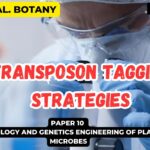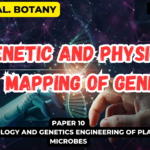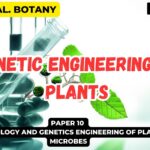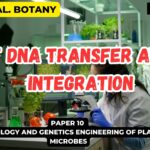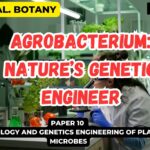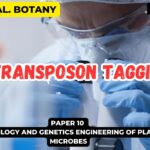![]()
Microbial Genetic Manipulation -Bacterial Transformation
- In molecular biology, transformation used to describe the insertion of new genetic material into nonbacterial cells, including animal and plant cells.
- Transformation can occur in two ways: natural transformation and artificial transformation.
- In cloning protocols, artificial transformation is used to introduce recombinant DNA into host bacteria (E. coli).
- Once the bacteria are transformed, those cells containing the plasmid are selected for and maintained using selective pressure from the selectable marker.
- Artificial transformation by using genetic engineering offers unlimited opportunities for creating new combinations of genes which leads to the development or improvement of strains and can be used by several industries.
- In addition transfer of nif gene among nitrogen fixing microbe leads the development in biological nitrogen fixation.
- Several microorganisms are used in fermentation technology, techniques for large-scale production of microbial products.
- It must both provide an optimum environment for the microbial synthesis of the desired product and be economically feasible on a large scale.
- They can be divided into surface (emersion) and submersion techniques.
- The latter may be run in batch, fed batch, continuous reactors 15.2 Bacterial Transformation In molecular biology, transformation is the genetic alteration of a cell resulting from the direct uptake and incorporation of exogenous genetic material (exogenous DNA) from its surroundings and taken up through the cell membrane(s).
- In 1928, the English scientist Frederick Griffiths was studying the bacterium Streptococcus pneumoniae.
- This organism causes pneumonia, which in 1928 was the leading cause of death in the Western countries.
- He was working with two strains of S. pneumoniae: among these one was virulent and caused disease (a pathogenic strain) while another one was non virulent did not cause disease.
- The pathogenic form of the organism produced an external polysaccharide coating that caused colonies of this strain growing on agar medium to appear smooth while nonpathogenic strain did not produce the coating, and its se colonies appeared rough.
- Griffiths’ experiments involved injecting mice with the S. pneumonia strains. When he used the smooth strain, the mice became ill and died.
- When he used the rough strain, they stayed healthy.
- In one series of experiments,
- Griffiths mixed heat-killed smooth cells (which had no effect when injected into mice) with living rough cells (which also had no effect when injected into mice) and injected the combination into mice.
- To his surprise, the mice became ill and died, as if they had been injected with living smooth cells.
- When Griffiths isolated S. pneumonia from the dead mice, he found that they produced smooth colonies.
- Griffiths concluded that the living rough cells had been transformed into smooth cells as the result of being mixed with the dead smooth cells.
- It was sixteen years before another group of investigators (Avery, McCarty, and MacLeod) showed that the “transforming principle,” the substance from the heat-killed smooth strain that caused the transformation, was DNA.
- Transformation occurs naturally in some species of bacteria, but it can also be affected by artificial means in other cells.
- For transformation to happen, bacteria must be in a state of competence, which might occur as a time-limited response to environmental conditions such as starvation and cell density.
- “Transformation” may also be used to describe the insertion of new genetic material into nonbacterial cells, including animal and plant cells; however, because “transformation” has a special meaning in relation to animal cells, indicating progression to a cancerous state, the term should be avoided for animal cells when describing introduction of exogenous genetic material.
- Introduction of foreign DNA into eukaryotic cells is often called “transfection”.
- Transformation can occur in two ways: natural transformation and artificial transformation.

Natural transformation
- Natural transformation describes the uptake and incorporation of naked DNA from the cell’s natural environment.
- It is a bacterial adaptation for DNA transfer that depends on the expression of numerous bacterial genes whose products appear to be responsible for this process. Some bacteria undergo transformation naturally.
- Streptococcus pneumonia is one of these, as are Neisseria gonorrhea (the causative agent of gonorrhea) and Haemophilus influenza (the principle cause of meningitis in children).
- Each of these organisms has surface proteins that bind to DNA inthe environment and transport it into the cell.
- Once inside the cell, the base sequence of the new DNA is compared to the bacterium’s DNA.
- If enough similarity in sequence exists, the new DNA can be substituted for the homologous region of the bacterium’s DNA.
- This is known as recombination. If the new DNA is not similar to the bacterium’s DNA, it is not incorporated into the genome and is broken down by intracellular enzymes.
- In general, transformation is a complex, energy-requiring developmental process. In order for a bacterium to bind, take up and recombine exogenous DNA into its chromosome, it must become competent, that is, enter a special physiological state.
- Competence development in Bacillus subtilis requires expression of about 40 genes.
- The DNA integrated into the host chromosome is usually (but with rare exceptions) derived from another bacterium of the same species, and is thus homologous to the resident chromosome.
- In B. subtilis the length of the transferred DNA is greater than 1271 kb (more than 1 million bases).
- The length transferred is likely double stranded DNA and is often more than a third of the total chromosome length of 4215 kb.
- It appears that about 7-9% of the recipient cells take up an entire chromosome.
- The capacity for natural transformation appears to occur in a number of prokaryotes, and thus far 67 prokaryotic species (in seven different phyla) are known to undergo this process.
Artificial transformation
- Still, it is rare for most bacteria to take up DNA naturally from the environment.
- But by subjecting bacteria to certain artificial conditions, we can enable many of them to take up DNA.
- Artificial transformation encompasses a wide array of methods for inducing uptake of exogenous DNA.
- In cloning protocols, artificial transformation is used to introduce recombinant DNA into host bacteria (E. coli).
- The most common method of artificial transformation of bacteria involves use of divalent cations (e.g., calcium chloride) to increase the permeability of the bacterium’s membrane, making them chemically competent, thereby increasing the likelihood of DNA acquisition.
- Another artificial method of transformation is electroporation, in which cells are shocked with an electric current, to create holes in the bacterial membrane.
- With a newly-compromised cell membrane, the transforming DNA is free to pass into the cytosol of the bacterium.
- Regardless of which method of tranformation is used, outgrowth of bacteria following transformation allows repair of the bacterial surface and selection of recombinant cells if the newly acquired DNA conveys antibiotic resistance to the transformed cells. .
- Once DNA is taken into a cell, the use of that DNA by the cell to make RNA and proteins is referred to as expression.
- In nature, the expression of the newly acquired DNA depends upon its being integrated into the DNA of the host cell.
- As discussed above, the process of integration is known as recombination, and it requires that the new DNA be very similar in sequence to the host genome.
- However, researchers usually want to introduce into a cell DNA that is quite different from the existing genome.
- Such DNA would not be recombined into the genome and would be lost.
- To avoid this problem, scientists transform host cells with plasmid DNA.
- A plasmid is a small, circular piece of double-stranded DNA that has an origin of replication.
- An origin of replication is a sequence of bases at which DNA replication begins.
- Because they contain origins of replication, plasmids are copied by the host cell’s DNA replication enzymes, and each daughter cell receives copies of the plasmid upon cell division.
- Therefore, plasmids do not need to be recombined into the genome to be maintained and expressed.
- Additionally, since plasmids do not have to have DNA that is similar to the host cell’s DNA, DNA from other organisms can be maintained as a plasmid.
- Fortunately, it is relatively easy to introduce new DNA sequences into plasmids. Plasmids naturally occur in bacteria and yeast, and they are widely used as vehicles for introducing foreign DNA into these organisms.
- Thus far, no analogs of plasmids are known for higher plants and animals, which is one reason why genetic engineering is so much more difficult in higher organisms.
- Selection of transformed bacteria Once the bacteria are transformed, those cells containing the plasmid are selected for and maintained using selective pressure from the selectable marker.
- Various antibiotic resistance gene acts as selectable marker.
- The antibiotics used in transformation are very similar (or the same) as antibiotics used to treat bacterial infections in humans.
- In medical situations, the term antibiotic resistance has a very negative connotation since it indicates an infection that cannot be successfully treated with antibiotics.
- However, antibiotic resistance has a far more positive meaning in biotechnology, since it is the end result of a successful transformation experiment.
- In a typical transformation, billions of bacteria are treated and exposed to plasmid DNA.
- Only a fraction (usually less than 1 in 1000) will acquire the plasmid.
- Antibiotic resistance genes provide a means of finding the bacteria which acquired the plasmid DNA in the midst of all of those bacteria which did not if the plasmid used to transform the DNA contains a gene for resistance to an antibiotic, then after transformation, bacteria that acquired the plasmid (transformants) can be distinguished from those that did not by plating the bacteria on a medium containing the antibiotic.
- Only the bacteria that acquired the plasmid will overcome the killing effect of the antibiotic and grow to form colonies on the plate.
- So the only colonies on an antibiotic plate after a transformation are the bacteria that acquired the plasmid.
- This procedure accomplishes our two goals of giving an advantage to cells that have a plasmid so the plasmid is retained and of having a marker so we know our cells contain new DNA.
- Resistance to an antibiotic is known as a selectable marker; that is, we can select for cells that contain it.
- There are other marker genes as well.
- One class of marker genes are color marker genes, which change the color of a bacterial colony.

